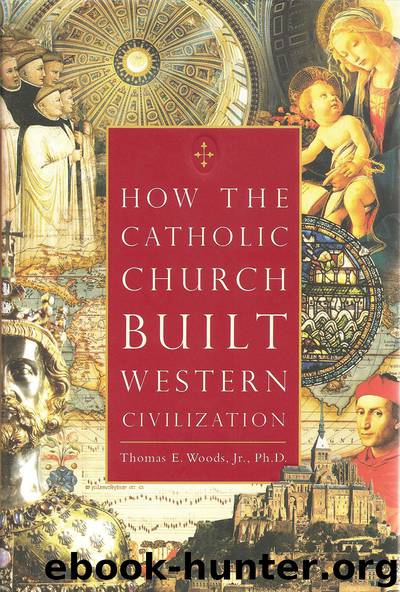How the Catholic Church Built Western Civilization by Thomas Woods Jr

Author:Thomas Woods Jr. [Woods, Thomas Jr.]
Language: eng
Format: epub
Tags: World, History
ISBN: 9781596983281
Google: jYvmAgAAQBAJ
Amazon: 1596983280
Publisher: Regnery Publishing
Published: 2012-09-18T21:09:58+00:00
Art and Science
In our discussion of the Church’s contributions to the development of modern science, we briefly explored how certain fundamental theological and philosophical ideas derived from Catholicism proved congenial to the enterprise of scientific inquiry. Oddly enough, our discussion of art can add still another explanation for the unique success of science in the West. It has to do with the development of linear perspective in art, perhaps the distinguishing feature of Renaissance painting.
It was in the West that perspective art, which involved the depiction of three dimensions in a two-dimensional artistic work, and chiaroscuro, the use of light and shadow, were developed. Both features had existed in the art of classical antiquity, and Western artists, beginning around 1300, revived them. It was only through Western influence that subsequent artists around the world applied these principles to their own traditional art.25
In The Heritage of Giotto’s Geometry, Samuel Edgerton compares the perspective art developed in pre-Renaissance and Renaissance Europe with the art of other civilizations. He begins with a comparison of a Western and a Chinese rendering of a fly, and shows that the Westerner is much more attentive to the geometric structure of the fly. “In the West,” he writes, “we take it for granted that if we are to understand the structure of an organic as well as an inorganic subject, we must first envisage it as nature mort (like a Chardin still life), with all constituent parts translated into impartial, static geometric relationships. In such pictures, as Arthur Waley wryly remarked, ‘Pontius Pilate and a coffee-pot are both upright cylindrical masses.’ To the traditional Chinese this approach is both scientifically and aesthetically absurd.” The point of Edgerton’s comparison is to emphasize that “the geometric perspective and chiaroscuro (light-and-shadow rendering) conventions of European Renaissance art, whether or not aesthetically styled, have proved extraordinarily useful to modern science.”26 This is why Edgerton suspects it is not a coincidence that Giotto, the forerunner and indeed the founder of Renaissance art, and Galileo, the brilliant physicist and astronomer who has sometimes been called the founder of modern science, both hailed from Tuscany, and that the Tuscan city of Florence was home to both artistic masterpieces and scientific advances.
The commitment of geometric perspective in art was itself a product of the distinct intellectual milieu of Catholic Europe. As we have seen, the idea of God as geometer, and of geometry as the basis upon which God ordered His creation, was one of long standing within the Catholic world. By the time of the Renaissance, explains Samuel Edgerton:
[A] unique tradition rooted in medieval Christian doctrine was growing in the West: it was becoming socially de rigueur for the privileged gentry to know Euclidian geometry. Even before the twelfth century, the early church fathers suspected they might discover in Euclidian geometry God’s very thinking process.
Geometric linear perspective was quickly accepted in western Europe after the fifteenth century because Christians wanted to believe that when they beheld such an image in art, they were perceiving
Download
This site does not store any files on its server. We only index and link to content provided by other sites. Please contact the content providers to delete copyright contents if any and email us, we'll remove relevant links or contents immediately.
The Gnostic Gospels by Pagels Elaine(2026)
Devil, The by Almond Philip C(1899)
Jesus by Paul Johnson(1887)
The Nativity by Geza Vermes(1849)
The Psychedelic Gospels: The Secret History of Hallucinogens in Christianity by Jerry B. Brown(1826)
Forensics by Val McDermid(1693)
Going Clear by Lawrence Wright(1571)
Going Clear: Scientology, Hollywood, and the Prison of Belief by Lawrence Wright(1570)
Barking to the Choir by Gregory Boyle(1507)
Old Testament History by John H. Sailhamer(1495)
Augustine: Conversions to Confessions by Robin Lane Fox(1473)
A History of the Franks by Gregory of Tours(1398)
A Prophet with Honor by William C. Martin(1373)
The Bible Doesn't Say That by Dr. Joel M. Hoffman(1372)
The Early Centuries - Byzantium 01 by John Julius Norwich(1359)
by Christianity & Islam(1347)
Dark Mysteries of the Vatican by H. Paul Jeffers(1341)
The First Crusade by Thomas Asbridge(1328)
The Amish by Steven M. Nolt(1253)
